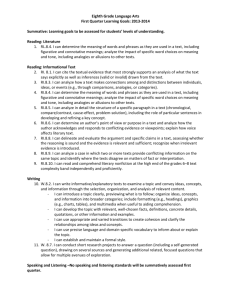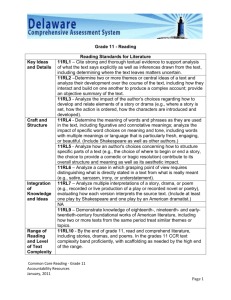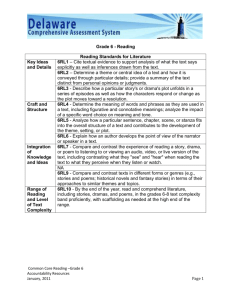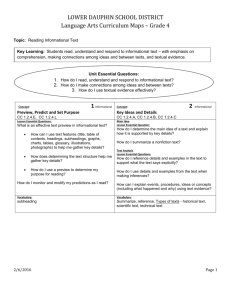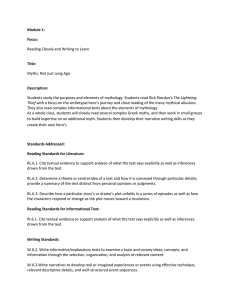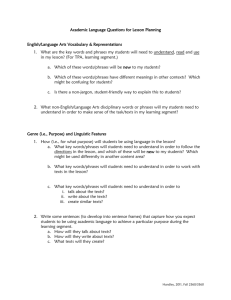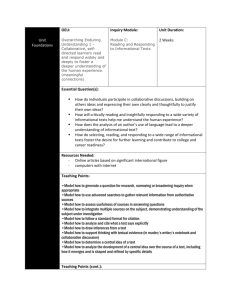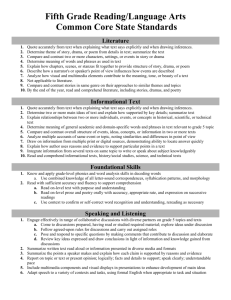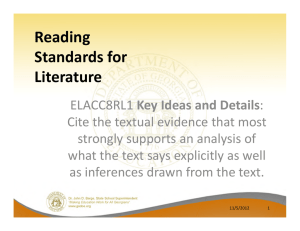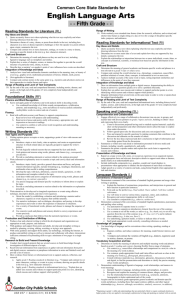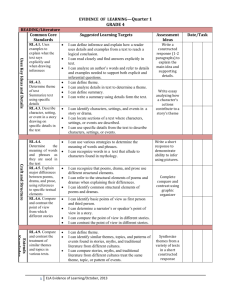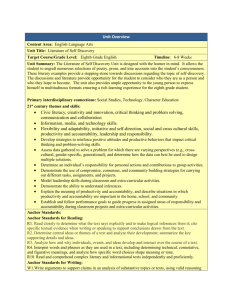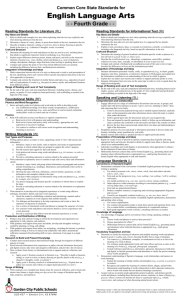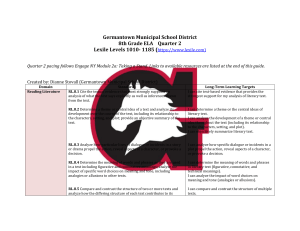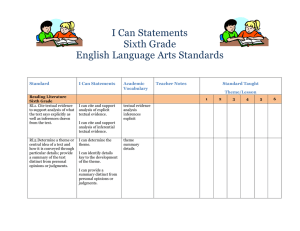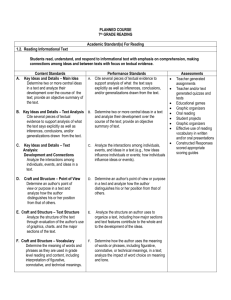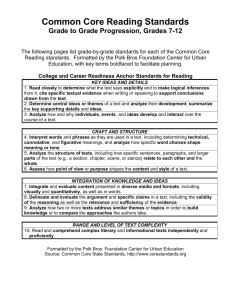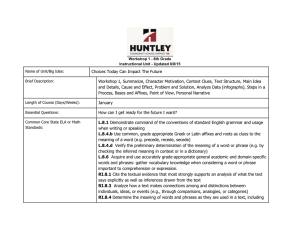8th Grade Planned Course
advertisement
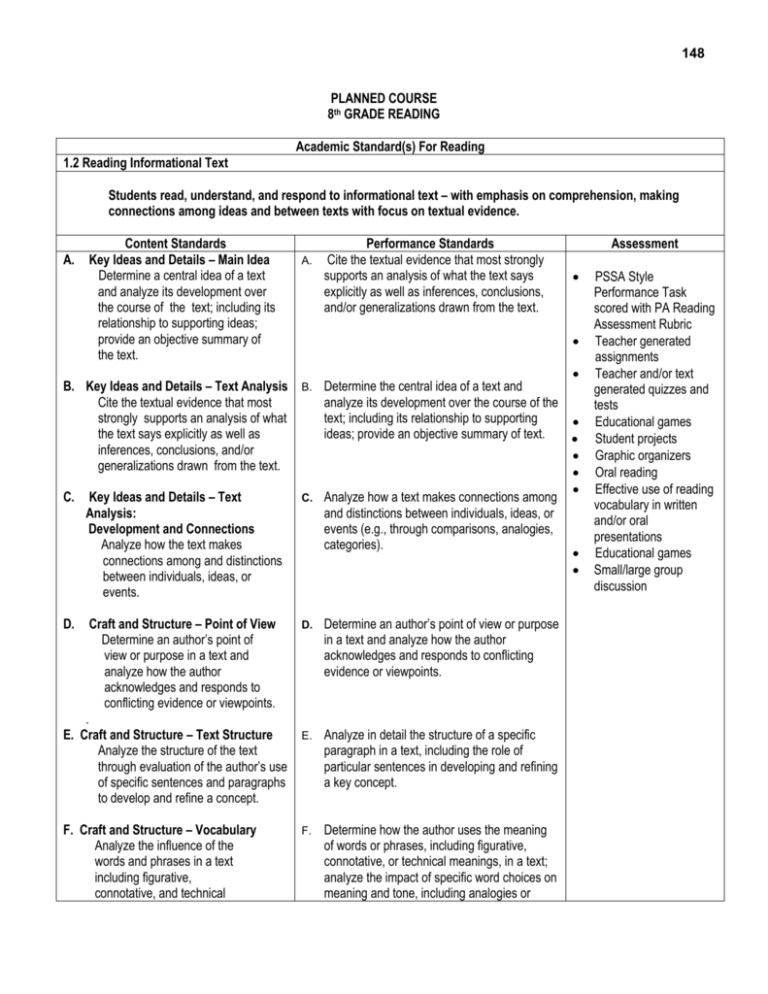
148 PLANNED COURSE 8th GRADE READING Academic Standard(s) For Reading 1.2 Reading Informational Text Students read, understand, and respond to informational text – with emphasis on comprehension, making connections among ideas and between texts with focus on textual evidence. A. Content Standards Key Ideas and Details – Main Idea Determine a central idea of a text and analyze its development over the course of the text; including its relationship to supporting ideas; provide an objective summary of the text. A. Performance Standards Cite the textual evidence that most strongly supports an analysis of what the text says explicitly as well as inferences, conclusions, and/or generalizations drawn from the text. Assessment B. Key Ideas and Details – Text Analysis B. Determine the central idea of a text and Cite the textual evidence that most analyze its development over the course of the strongly supports an analysis of what text; including its relationship to supporting the text says explicitly as well as ideas; provide an objective summary of text. inferences, conclusions, and/or generalizations drawn from the text. C. Key Ideas and Details – Text C. Analyze how a text makes connections among Analysis: and distinctions between individuals, ideas, or Development and Connections events (e.g., through comparisons, analogies, Analyze how the text makes categories). connections among and distinctions between individuals, ideas, or events. D. Craft and Structure – Point of View Determine an author’s point of view or purpose in a text and analyze how the author acknowledges and responds to conflicting evidence or viewpoints. . E. Craft and Structure – Text Structure Analyze the structure of the text through evaluation of the author’s use of specific sentences and paragraphs to develop and refine a concept. F. Craft and Structure – Vocabulary Analyze the influence of the words and phrases in a text including figurative, connotative, and technical D. Determine an author’s point of view or purpose in a text and analyze how the author acknowledges and responds to conflicting evidence or viewpoints. E. Analyze in detail the structure of a specific paragraph in a text, including the role of particular sentences in developing and refining a key concept. F. Determine how the author uses the meaning of words or phrases, including figurative, connotative, or technical meanings, in a text; analyze the impact of specific word choices on meaning and tone, including analogies or PSSA Style Performance Task scored with PA Reading Assessment Rubric Teacher generated assignments Teacher and/or text generated quizzes and tests Educational games Student projects Graphic organizers Oral reading Effective use of reading vocabulary in written and/or oral presentations Educational games Small/large group discussion 149 meanings, and how they shape meaning and tone. allusions to other texts. G. Integration of Knowledge and Ideas – Diverse Media Evaluate the advantages and disadvantages of using different mediums (e.g. print or digital text, video, multimedia) to present a particular topic or idea. H. Integration of Knowledge and Ideas – Evaluating Arguments Evaluate an author’s arguments, reasoning, and specific claims for the soundness of the argument and the relevance of the evidence. H. Delineate and evaluate the argument and specific claims in a text, assessing whether the reasoning is sound and the evidence is relevant and sufficient; recognize when irrelevant evidence is introduced. I. Integration of Knowledge and Ideas – I. Analyze a case in which two or more texts Analysis Across Texts provide conflicting information on the same topic, Analyze two or more texts that provide and identify where the texts disagree on matters conflicting information on the same topic of fact or interpretation. and identify where the texts disagree on matters of fact or interpretation. J. Vocabulary Acquisition and Use J. Determine or clarify the meaning of unknown Acquire and use accurately gradeand multiple-meaning words or phrases based appropriate general academic and on grade 8 reading and content, choosing domain-specific words and phrases; flexibly from a range of strategies: gather vocabulary knowledge when a. Use context (e.g., the overall meaning of a considering a word or phrase important sentence or paragraph; a word’s position or to comprehension or expression. function in a sentence) as a clue to the meaning of a word or phrase. b. Use common, grade-appropriate Greek or Latin affixes and roots as clues to the meaning of a word (e.g., precede, recede, secede). c. Determine meaning of technical words and phrases used in a text. K. Vocabulary Acquisition and Use Determine or clarify the meaning of unknown and multiple-meaning words and phrases based on grade level reading and content, choosing flexibly from a range of strategies and tools. K. Demonstrate understanding of figurative language, word relationships, and nuances in word meanings. a. Interpret figures of speech (e.g., verbal irony, puns) in context. b. Use the relationship between particular words to better understand each of the words. c. Distinguish among the connotations (associations) of words with similar 150 denotations (definitions) (e.g., bullheaded, willful, firm, persistent, resolute). L. Range of Reading Read and comprehend literary non-fiction and informational text on grade level, reading independently and proficiently. L. Demonstrate comprehension of literary non-fiction and informational text on grade level.



